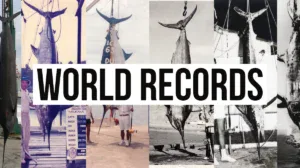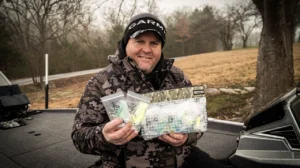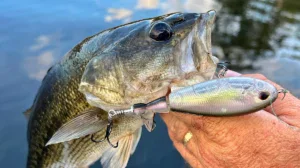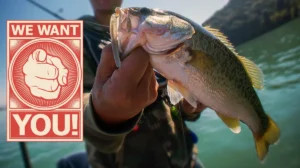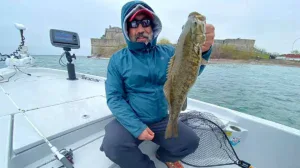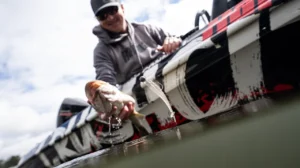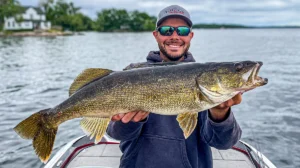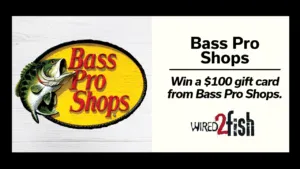Many anglers turn their noses up at the early post-spawn; they consider it a tough time of year to go bass fishing. And while, yes, the fishing certainly slows down a bit, this is still one of the best times of year to target bass shallow. As the bass spawn winds down and the post-spawn phase kicks in, look for bass to still be feeding heavily in less than 10 feet of water.
There are certainly some that go into a post-spawn funk, a little shell-shocked from the bedding process and disinterested in biting anything. But there are far more that are catchable, from the last few spawners, to bass guarding their fry, to bass gorging themselves on shad spawns and other prevalent forage. The early post spawn is one of the best times of the year to catch bass shallow. Here’s how to do it.
The Last Few Spawners

Not all bass in a fishery spawn at the same time. The water temperature is believed to be one of the primary factors that notifies a bass it’s time to spawn. So, it stands to reason that resident shallow fish would spawn much sooner than a bass that’s sitting in 20 feet of water.
As the main spawn finishes up, you can often find a few remaining spawners by looking for areas of the lake that have deeper or colder water nearby. Main lake pockets, for example, are great places to seek out fish that are late to the game. Rivers and creeks with current are typically a little colder than the main lake as well, so bass spawn later in these areas.
Once you find a last-minute spawner, slow down and fish for it by putting your bait right in the middle of the bed and working it as close to in place as possible. Texas rigs, Tokyo rigs, and drop shots are the easiest baits to do this with. But keep in mind, you’re trying to mimic something that poses a threat to their eggs, so sometimes you’ll have to break out the big guns and toss a swimbait over into the bed to get them to bite.
Fry Guarders

Immediately after bass eggs hatch out, these tiny bass school up to form balls of fry. Given their size, they are extremely susceptible to the threat of predators like bluegill, other bass, and even their mothers — the female bass are notorious for turning on their young right away and eating them. For this reason, the male bass hangs around the fry, keeping them corralled near cover while he wards off any aggressors in the area.
Setting aside the conversation on the morality or sustainability of this style of fishing for the moment, these male bass are usually easy to catch.
In clear water, you can see them and their fry with your naked eye at times, but even better with a good pair of polarized sunglasses. Throwing a wacky rig Senko past the ball of fry and working it towards them is often all it will take to get the bass to eat. You can sometimes even find the bigger female still lurking nearby.
The ladies are usually far tougher to catch; staying way back and throwing a finesse bait like a Fluke, floating worm, Neko rig, wacky rig, or drop shot is your best bet there.
Shad Spawn

Depending on the fishery you’re on, there’s often a shad spawn starting up towards the back half of the bass spawn. Where bass spawn by pairing up and creating a bed in shallow water, shad spawn in a completely different manner. These little guys group up by the thousands and work up and down any type of cover they can find, using the cover to rub the eggs out of their bellies.
In the process of doing this, the shad draw the attention of bass in the area. As soon as one bass blows up on the preoccupied shad, another hears the commotion and joins in. Pretty soon you can have dozens of bass gorging themselves on the shad. If you stumble upon such a scene, you can insert a spinnerbait, swim jig, or topwater into the situation and have an absolute blast.
The only issue is that these shad spawns are typically short-lived, most dissipating as soon as the sun gets up. So, you’ll want to get out on the water early if you’re going to look for one.
Again, these can be on any type of cover, even floating debris out in the middle of the lake. But seawalls, marina docks, and grass lines are fantastic places to look first. To further narrow down the search, keep your eyes peeled for gulls, heron, and other birds that can tip you off to a concentration of shad.
Bream Beds

Just as the bass spawn officially finishes, blue gill and other bream start to spawn in the same shallow areas where the bass have bedded all spring. This brings another food source right to the doorstep of the hungry bass that are still in the area.
Bream spawn in a different way than both the shad and the bass. They do still form beds on the bottom like bass, but these fish wallow out cooking-pot-size divots in the ground as opposed to just fanning a clean spot. And where bass pairs make individual beds, dozens of bream group up at times to create one big bream bed, which looks like a honeycomb structure of individual beds.
As early-post-spawners meander down the shoreline in search of food, they inevitably run into these bream beds, and then chaos ensues. The bass tear through the beds trying to snag a bream, often to no avail. But if you happen upon this scene, you should try presenting that bass with exactly what it thinks it wants — an injured bream.
Throwing subtle baits like wacky rigs and drop shots into and around bream beds is a great way to trick a bass into biting. But it’s a lot more fun to throw a giant wakebait or topwater over top of the bream bed and trigger an explosion if you want to give that a try.
Topwater Time

During the early post-spawn, you should be able to still find several fish shallow by just fishing down the bank. There may not be as many shallow as there were during the spawn since some bass shoot straight out to deeper water as soon as they finish up, but there are still several big ones to be caught. And locking a topwater in your hand and covering water is a great way to get an exhilarating bite.
Topwaters like Whopper Ploppers, hollow-body frogs, toads, Spooks, poppers, and buzzbaits work extremely well around shallow grass, wood, seawalls, docks, and any other cover you can find.
Try to put your bait in the shade any chance you get, and make sure to select the most suitable bait for each cover type, like a frog for a lily pad field as opposed to a Spook, which is much more likely to hang. Throw the Spook instead around isolated wood, and then a buzzbait down a seawall, and so on.
Final Thoughts

The early post-spawn is a fantastic time of year to fish shallow. The bass may be a little fewer and further in between, and they can be a little harder to catch at times, but they are still big and hungry. There are a few ways to better your odds of catching them.
For starters, start early; get out on the water at the crack of dawn and look for birds, which will likely indicate the presence of shad and, hopefully, a shad spawn.
As the morning wears on, keep an eye out for the last few spawners, and be looking for bream beds, too. Keeping a topwater in your hand as you cover water shallow looking for these beds will give you a good chance to catch a big one while in search mode.
Don’t forget to keep your eyes peeled for balls of fry, typically the size of a beachball or smaller. If you do all of this, you can turn what most believe to be a tough time to fish into a lot of fun on the water.



